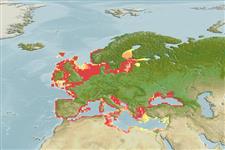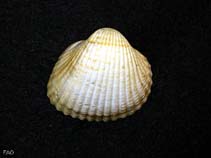Cerastoderma glaucum (Bruguière, 1789)
Olive green cockle| Native range | All suitable habitat | Point map | Year 2050 |

|
| This map was computer-generated and has not yet been reviewed. |
| Cerastoderma glaucum AquaMaps Data sources: GBIF OBIS |
Classification / Names Populärnamn | synonymer | CoL | ITIS | WoRMS
Bivalvia | Cardiida | Cardiidae
Environment: milieu / climate zone / djupintervall / distribution range Ekologi
; brackvatten; djupintervall 0 - 83 m (Ref. 101447). Subtropical; 64°N - 30°N, 11°W - 51°E
Distribution Länder | FAO områden | Ekosystem | Förekomster | Utplanteringar
Northeast Atlantic, the Mediterranean and the Caspian Sea. Subtropical to temperate.
Length at first maturity / Size / Weight / Age
Könsmognad: Lm 0.7 range ? - ? cm
Life cycle and mating behavior Könsmognad | Reproduktion | Lek | Eggs | Fecundity | Larvae
Main reference
referenser | Koordinator | Medarbetare
Zenetos, A., E. Vardala-Theodorou and C. Alexandrakis 2005 Update of the marine Bivalvia Mollusca checklist in Greek Waters. J. Mar. Biol. Ass. U.K. 85:993-998. (Ref. 2684)
IUCN Red List Status
(Ref. 130435: Version 2025-1)
CITES status (Ref. 108899)
CMS (Ref. 116361)
Threat to humans
Human uses
Fiskeri: kommersiell
| FishSource |
Verktyg
Ytterligare information
Max. ages / sizes
Length-weight rel.
Length-length rel.
Length-frequencies
Mass conversion
Abundans
Internet-källor
BHL | BOLD Systems | CISTI | DiscoverLife | FAO(Publication : search) | Fishipedia | GenBank (genome, nucleotide) | GloBI | Gomexsi | Google Books | Google Scholar | Google | PubMed | Tree of Life | Wikipedia (Go, sök) | Zoological Record



